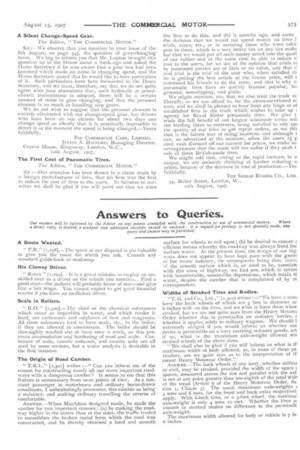Answers to Queries.
Page 19

If you've noticed an error in this article please click here to report it so we can fix it.
Our readers will be informed by the Editor on any Points connected with the construction or use of commercial motors. Where
a direct reply is desired, et stamped and addressed envelope should be enclosed : if a request for Privacy is not sPecially made, any query and answer may be published.
A Route Wanted.
" P.R." [I,298].—The space at our disposal is too valuable to give you the route for which you ask. Consult any standard guide-book or road-map.
His Clumsy Driver.
" Rotax " ft,29911.—It is a great mistake to employ an un-. skilled man as a driver on the vehicle you mention. Find a good man—the makers will probably know of one—and give him a fair wage. You cannot expect to get good financial results if you have an inefficient driver.
Scale in Boilers.
" R.O." ii,300].—The chief of the chemical substances which occur as impurities in water, and which render it hard, are carbonates and sulphates of lime and magnesia. All these substances tend to form scale, etc., in the boiler, if they are allowed to concentrate. The boiler should be thoroughly washed out at least once a week, as this prevents accumulation and hardening of mud and scale. Carbonate of soda, caustic soda-ash, and caustic soda are all used by some owners, but a water analysis is desirable in the first instance.
The Origin of Road Camber.
" [1,301] writes :—" Can you inform me of the reason for constructing nearly all our more important roadways with a dangerous camber? It seems to me that this feature is unnecessary from most points of view. As a constant passenger in motorbuses and ordinary horse-drawn omnibuses, I unhesitatingly pronounce this camber as being a nuisance, and making ordinary travelling the reverse of comfortable.
ANSWER.—When MacAdam designed roads, he made the camber for two important reasons : (a) by making the roadway higher in the centre than at the sides, the traffic tended to consolidate the broken metal from which the road was constructed, and he thereby obtained a hard and smooth
surface for wheels to roll upon; (b) he desired to ensure efficient means means whereby the roadway was always freed fro. surface water. At the present time, the design of our big ways does not appear to have kept pace with the growl of the motor industry, the consequence being that, instu of the smooth surface which is, or used to be, associatt with this class of highway, we find one which is cover( with innumerable, saucer-like depressions, which retain ti water, despite the camber that is complained of by ca correspondent.
Widths of Straked Tires and Bodies.
"T. G. and Co., ,Ltd.," [1,302i writes :—"We have a mot( lorry the back wheels of which are 3 feet in diameter at 6 inches wide on the tires, and we wish to have these whee stroked, but we are not quite sure from the Heavy Motorct Order whether this is permissible on ordinary lorries, 4: whether it applies solely to military wagons. We should I extremely obliged if you would inform us whether suc device is permissible on a lorry carrying ordinary goods, an if so, what is the maximum axle-weight allowed wit straked wheels of the above sizes. "We shall also be glad if you will inform us what is a maximum width of body allowed, as, in none of these pa ticulars, are we quite sure as to the interpretation of ti recent Heavy Motorcar Order." ANSWER.—The back wheels of any lorry, whether militai or civil, may be straked, provided the width of the space ( spaces, measured across the tire and parallel with the axl is not at any point greater than one-eighth of the total with of the tread (Article 6 of the Heavy Motorcar Order, Se tion 1, Clause 3). The usual maximum axle-weights 4 4 tons and 8 tons, for the front and back axles respectivel: apply. With 6-inch tires, or a 3-foot wheel, the maximum axle-weight is only 4 tons in cwt. Whether the tires am smooth or straked makes no difference to the permissib axle-weight.
The maximum width allowed for body or vehicle is 7 fe. 6 inches
























